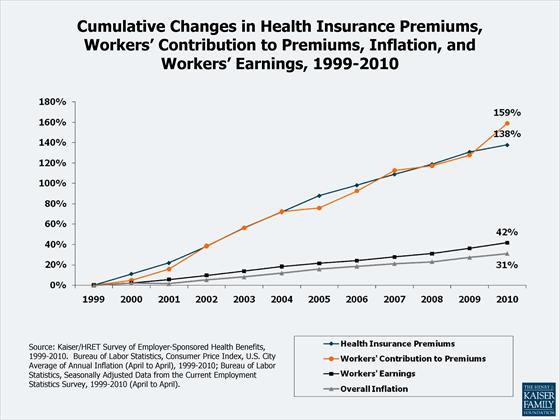October 11th, 2011 by DavedeBronkart in Health Policy, Opinion
No Comments »

Last week the New York Times reported that some health insurers have applied to regulatory agencies to push premiums sharply higher – usually double-digit increases, while citizens are suffering. This falls on top of the 11 year history reported last year by the Kaiser Family Foundation: wages and inflation are up ~40%, while health costs and worker contributions were up 138% and 159%:

No wonder we feel squeezed. (Last week’s announcement comes on top of this history.)
This has enormous human impact. Read more »
*This blog post was originally published at e-Patients.net*
September 27th, 2011 by RyanDuBosar in Research
No Comments »

Intranasal insulin stabilized or improved cognition and function and preserved cerebral metabolic rate of glucose in brain regions affected by Alzheimer’s disease, concluded researchers from a phase II trial. But more and larger trials are needed before any conclusions can be drawn, they also cautioned.
 Insulin is important to normal brain function, and reduced insulin levels may contribute to Alzheimer’s disease, researchers noted. To examine the effects of intranasal insulin in adults with amnestic mild cognitive impairment or Alzheimer’s disease, researchers conducted a randomized, double-blind, placebo-controlled trial in a VA medical center.
Insulin is important to normal brain function, and reduced insulin levels may contribute to Alzheimer’s disease, researchers noted. To examine the effects of intranasal insulin in adults with amnestic mild cognitive impairment or Alzheimer’s disease, researchers conducted a randomized, double-blind, placebo-controlled trial in a VA medical center.
The intent-to-treat sample consisted of 104 adults with amnestic mild cognitive impairment (n=64) or mild to moderate Alzheimer’s disease (n=40) defined as Clinical Dementia Rating scores of 0.5-1 and Mini-Mental State Examination scores greater than 15.
Participants received Read more »
*This blog post was originally published at ACP Internist*
September 22nd, 2011 by Dinah Miller, M.D. in Opinion
No Comments »


 I’m posting this because Roy fell asleep at the wheel and missed the Xanax article on the front page of yesterday’s New York Times. In “Abuse of Xanax Leads a Clinic to Halt Supply,” Abby Goodnough writes about a clinic where they’ve stopped prescribing Xanax because to many people are abusing it. Goodnough writes:
I’m posting this because Roy fell asleep at the wheel and missed the Xanax article on the front page of yesterday’s New York Times. In “Abuse of Xanax Leads a Clinic to Halt Supply,” Abby Goodnough writes about a clinic where they’ve stopped prescribing Xanax because to many people are abusing it. Goodnough writes:
“It is such a drain on resources,” said Ms. Mink, whose employer, Seven Counties Services, serves some 30,000 patients in Louisville and the surrounding region. “You’re funneling a great deal of your energy into pacifying, educating, bumping heads with people over Xanax.”
Because of the clamor for the drug, and concern over the striking number of overdoses involving Xanax here and across the country, Seven Counties took an unusual step Read more »
*This blog post was originally published at Shrink Rap*
September 18th, 2011 by DrWes in Health Policy
No Comments »

It was kind of funny reading this recent article from the New York Times that focuses on a relatively small health data breach from Stanford Hospital’s emergency room:
A medical privacy breach involving Stanford Hospital in Palo Alto, Calif., led to the public posting of data for 20,000 emergency room patients, including names and diagnosis codes, on a commercial Web site for nearly a year, the hospital has confirmed.
Since discovering the breach last month, the hospital has been investigating how a detailed spreadsheet made its way from one of its vendors, a billing contractor identified as Multi-Specialty Collection Services, to a Web site called Student of Fortune, which allows students to solicit paid assistance with their schoolwork.
Gary Migdol, a spokesman for Stanford Hospital and Clinics, said the spreadsheet first appeared on the site on Sept. 9, 2010, as an attachment to a question about how to convert the data into a bar graph.
Although medical security breaches are not uncommon, the Stanford breach was notable for Read more »
*This blog post was originally published at Dr. Wes*
September 15th, 2011 by Davis Liu, M.D. in News, Opinion
No Comments »

 One of my favorite movies is Back to the Future starring Michael J. Fox. I must admit after reading this New York Times piece, titled “When Computers Come Between Doctors and Patients” I have to wonder.
One of my favorite movies is Back to the Future starring Michael J. Fox. I must admit after reading this New York Times piece, titled “When Computers Come Between Doctors and Patients” I have to wonder.
Am I fortunate to be coming from the future? Because I completely disagree with Dr. Danielle Ofri, again.
I’ve had the privilege and opportunity to work in a medical group which has deployed the world’s largest civilian electronic medical record and have been using it since the spring of 2006. I don’t see the issue quite as much as Dr. Ofri did. It is possible that she examined patients in her office with a desk rather than an examination room.
If placed and mounted correctly in the exam room, the computer actually is an asset and can improve the doctor patient relationship. It is part of the office visit. The flat screen monitor can be rotated to begin a meaningful dialogue between the patient and me. Read more »
*This blog post was originally published at Saving Money and Surviving the Healthcare Crisis*




















